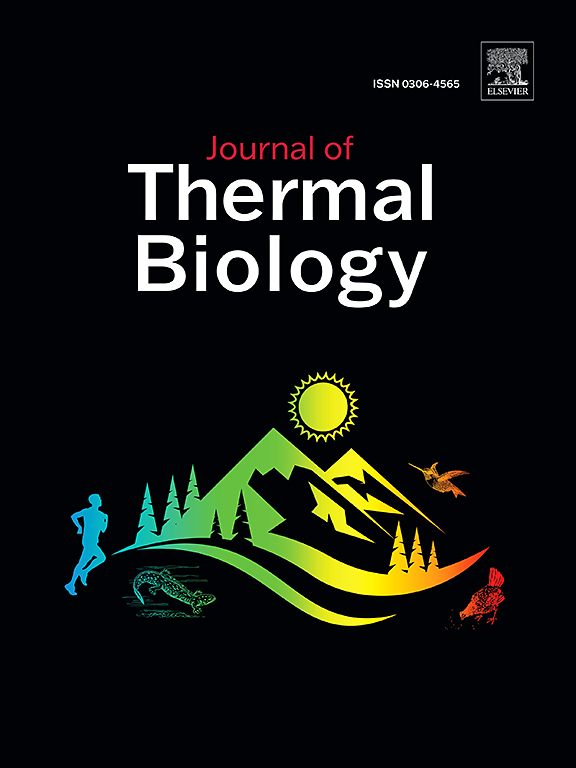尼日尔萨赫勒地区小型反刍动物对环境压力的形态适应性以及与胴体产量的潜在联系。
IF 2.9
2区 生物学
Q2 BIOLOGY
引用次数: 0
摘要
本研究分析了尼日尔萨赫勒地区绵羊和山羊的形态特征对环境压力的反应,以及适应性特征对畜群生产力的贡献。这项研究利用了尼日尔北纬地区干旱梯度明显的 13 个地点的 2490 只成年小型反刍动物,包括 653 只红山羊和萨赫勒山羊以及 1837 只 Peulh(有三个品种:Balami、Oudah 和 Bali-Bali)绵羊和图阿雷格(Ara-ara)绵羊。对 1617 只成年绵羊和山羊(分别为 876 只和 741 只)的第二个样本进行了胴体产量评估。对不同气候区和品种的胸廓耳廓指数(耳长与胸廓深度之比)、匀称指数(反映动物身体从地面减去的部分)和热胴体产量进行了5%风险临界值的方差分析。主成分分析法用于分析生物特征指数和发情指数之间的相关性。就大多数品种而言,干旱地区动物的耳廓胸廓指数和匀称指数高于潮湿地区。身体指数平均值的增加导致动物胴体产量和活重的增加。在所有绵羊和山羊品种中,随着热指数的升高,体质指数也随之升高。绵羊和山羊的体质指数不同(p本文章由计算机程序翻译,如有差异,请以英文原文为准。
Morphological adaptation to environmental stress in small ruminants from the sahelian zones of Niger and potential associations with carcass yield
This study analyses, in the Sahelian zone of Niger, the morphological traits of sheep and goats' responses to environmental stress and the contribution of adaptive traits to herd productivity. The study utilized 2490 adult small ruminants, including 653 red and Sahelian goats and 1837 Peulh (with three varieties: Balami, Oudah and Bali-Bali) and Tuareg (Ara-ara) sheep from 13 sites with a marked aridity gradient within the country's northern latitude. Carcass yield was assessed on a second sample of 1617 adult animals, comprising 876 sheep and 741 goats. Variations in thorax auricular index (ratio of ear length to thorax depth), gracility index (which reflects the subtraction of the animal's body from the ground) and hot carcass yield, according to climate zones and breed, were subjected to an analysis of variance at the 5% risk threshold. Principal Component Analysis was used to analyze correlations between biometric and heat indices. For most breeds, the auricular thorax index and the gracility index were higher for animals in arid zones than those in humid zones. The increase in the average values of the body indices had as a result an increase in the animals' carcass yield and live weight. In all sheep and goat breeds, gracility increases with heat index. Gracility differed (p < 0.05) between breeds, with Bali-Bali and Oudah subgenetics of the Peulh sheep breed being more gracile than the Ara-ara sheep. Also, the auricular thorax index was higher (p < 0.05) in Sahelian goat than in red goat. The importance of biometric indices in terms of animals' adaptability to their environment means that we need to define important heat stress indicators specific to sheep and goats in Sahelian farming systems.
求助全文
通过发布文献求助,成功后即可免费获取论文全文。
去求助
来源期刊

Journal of thermal biology
生物-动物学
CiteScore
5.30
自引率
7.40%
发文量
196
审稿时长
14.5 weeks
期刊介绍:
The Journal of Thermal Biology publishes articles that advance our knowledge on the ways and mechanisms through which temperature affects man and animals. This includes studies of their responses to these effects and on the ecological consequences. Directly relevant to this theme are:
• The mechanisms of thermal limitation, heat and cold injury, and the resistance of organisms to extremes of temperature
• The mechanisms involved in acclimation, acclimatization and evolutionary adaptation to temperature
• Mechanisms underlying the patterns of hibernation, torpor, dormancy, aestivation and diapause
• Effects of temperature on reproduction and development, growth, ageing and life-span
• Studies on modelling heat transfer between organisms and their environment
• The contributions of temperature to effects of climate change on animal species and man
• Studies of conservation biology and physiology related to temperature
• Behavioural and physiological regulation of body temperature including its pathophysiology and fever
• Medical applications of hypo- and hyperthermia
Article types:
• Original articles
• Review articles
 求助内容:
求助内容: 应助结果提醒方式:
应助结果提醒方式:


